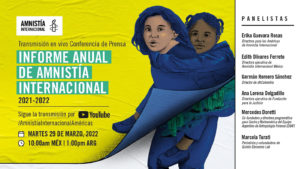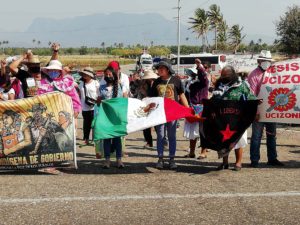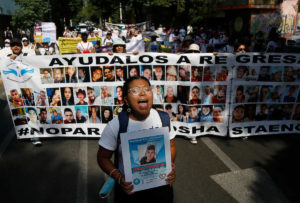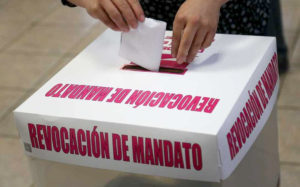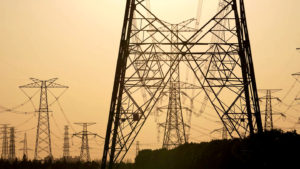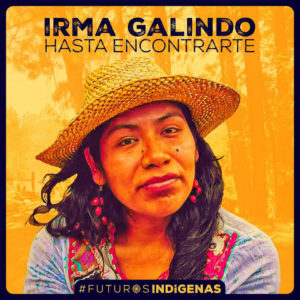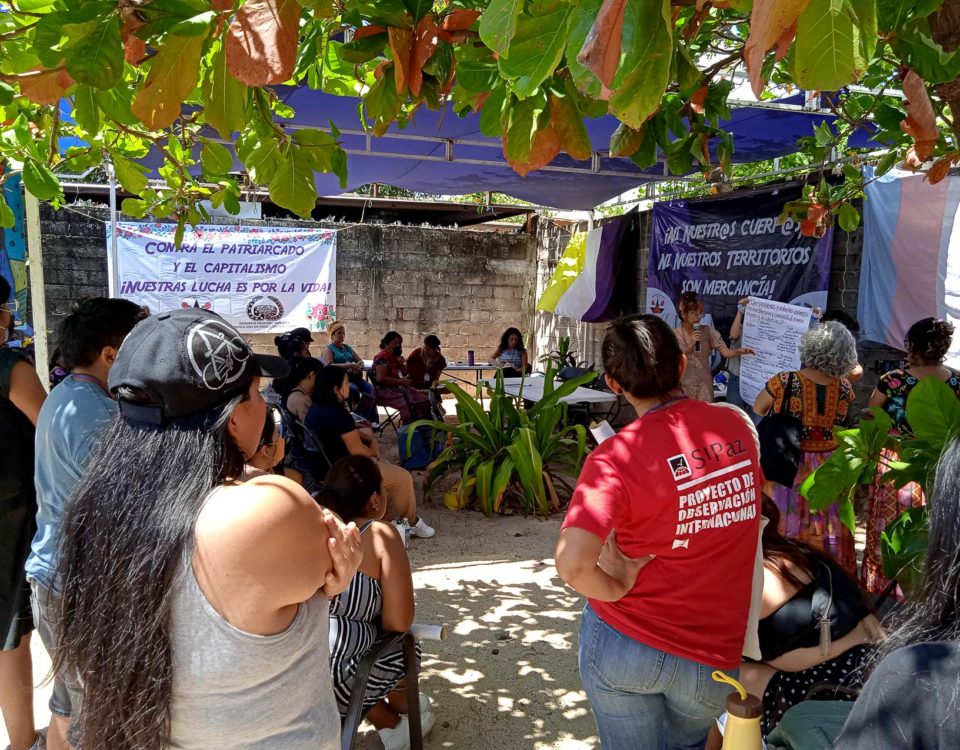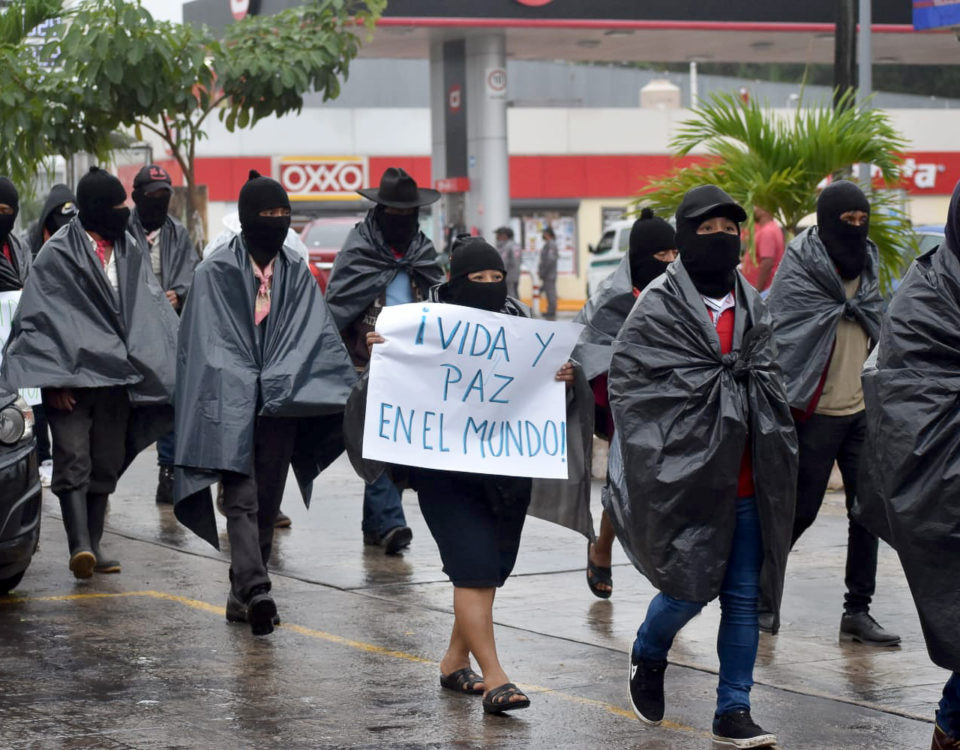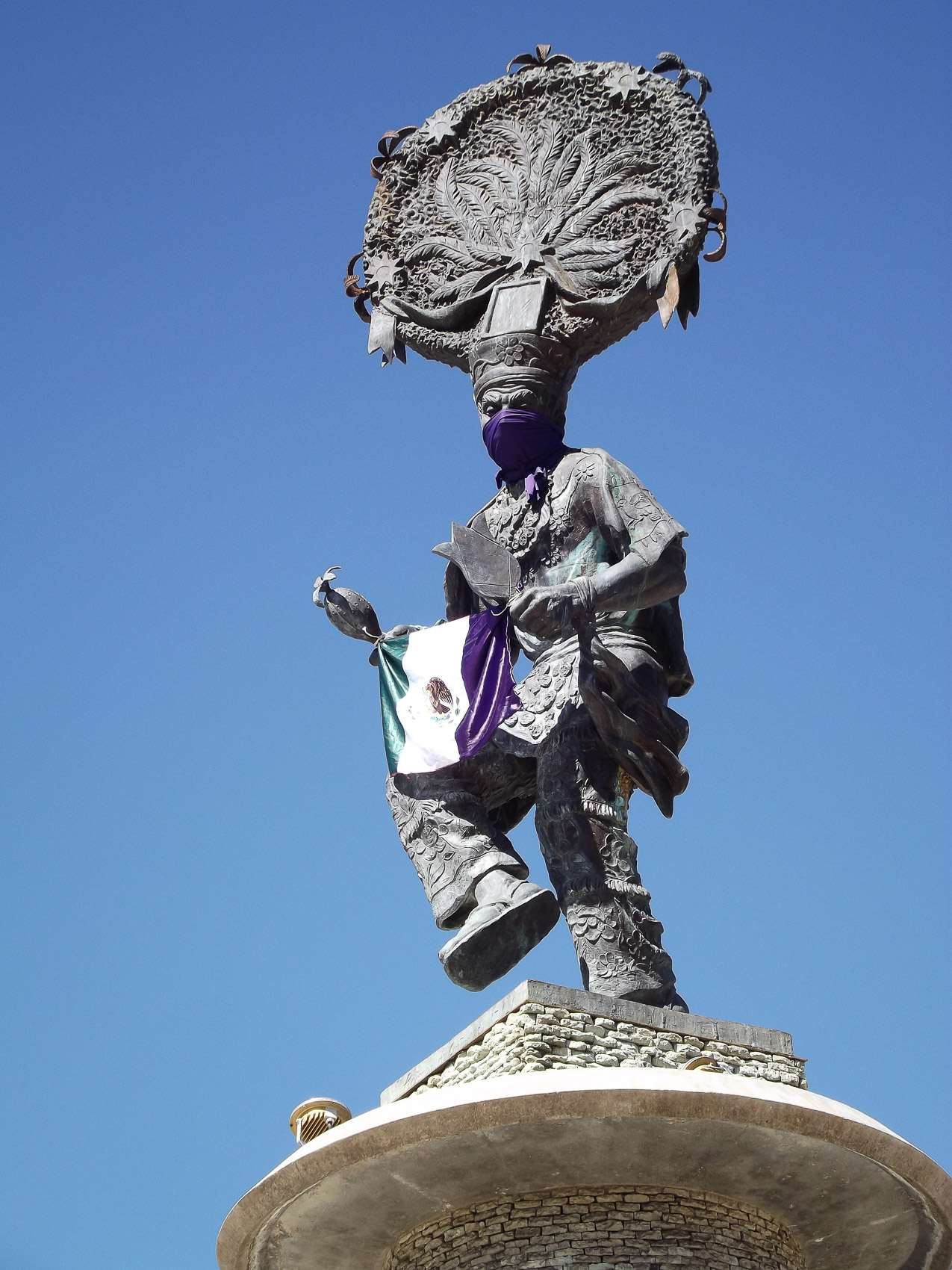
SIPAZ activities (From mid-November 2021 to mid-February 2022)
03/03/2022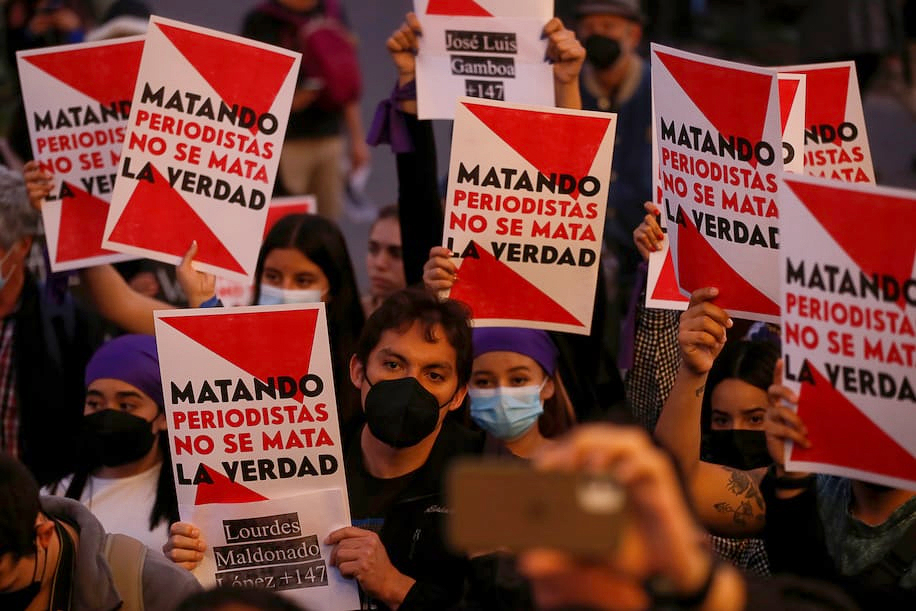
FOCUS: Violence Crisis Crosses the Right to Freedom of Expression in Mexico
04/06/2022
I n March, Amnesty International (AI) presented its report on the human rights situation in 2021 and the beginning of 2022 through an event held in Mexico City.
It stressed that “Mexico continues to experience a serious human rights crisis that is manifested not only in the large number of people whose fundamental rights are constantly violated, but in 2021 we observe with great concern the risk of reducing civic space that is seen in the constant attacks on civil society organizations, the press, and human rights defenders.”
In other points of concern, it mentioned the “advance of militarization”, since in 2021 “the largest number of military personnel was deployed since the war on drug trafficking began in 2006” through mobilizing 99,946 military personnel. Likewise, beyond the militarization of public security, more and more tasks have been assigned to the Armed Forces for the control of customs, ports, public works of megaprojects, among others.
AI was also concerned about the issue of forced disappearances when in 2021 at least 7,698 cases of missing and unlocated persons in the country were documented. With this, at the end of the year the number of disappeared persons rose to 97,000 since 1964. Furthermore, “facing these figures, impunity continues; by 2021, only 35 convictions had been handed down for the crime of forced disappearance.”
Another issue of concern was migration due to reports of excessive use of force and arbitrary returns by authorities, as well as kidnappings, extortion and homicides by non-state players. It considered that the management of migration by the National Guard “constitutes a serious risk for respect for the rights and guarantees of migrants.”
Of particular concern: the situation of human rights defenders and freedom of expression
In March, the Mexican Center for Environmental Law (CEMDA) presented a report on the situation of environmental defenders and communities in Mexico. It pointed out that, in 2021, 25 environmental defenders were murdered and 238 attacks of different types were presented, almost 165% more than in 2020. So far in the current administration, 58 environmental defenders have been murdered. In the reasons to explain so much violence, CEMDA points out “environmental processes that are not carried out legally, that are not culturally appropriate, that do not respect the rights to information, participation or autonomy (…) Secondly, the slowness and omission of the judiciary to resolve socio-environmental conflicts (…) stands out. In addition, in some cases it contributes to validating acts of criminalization against human rights defenders. In the third place, public prosecutor’s offices persist in failing to investigate acts of violence; finally, the ineffectiveness of the protection mechanisms stands out.”
In April, the organization in defense of freedom of expression Article 19 presented its 2021 report entitled “Denial”. In it, it documents that, in 2021, an attack against the press was recorded every 14 hours with a total of 644 attacks. “The Mexican state was involved in two out of every five attacks”, it stressed. The three years of AMLO’s government add up to 1,945 attacks against the press, among which are 30 murders of journalists, “marking the most violent period against the press on record.” In addition, in 2021 “the tendency to deny and make problems related to human rights disappear from public discourse was consolidated”, hence the title of the report. Article 19 stated that “this denial translates into official misinformation, public stigmatization of the press, discretion in the allocation of official advertising, deception in the transparency system, violence against the press, digital divide, and human rights violations.”
By mid-May, 11 murders of journalists had been documented since the beginning of 2022, a figure higher than countries that are in a war conflict and positioning Mexico as the deadliest country for the press.
Worrying tendency of the federal government to deny or minimize the accusations in the matter of human rights
In March, the European Parliament passed a resolution stressing that “Mexico has long been the most dangerous and deadliest place for journalists outside of an official war zone.” It asked the Mexican authorities for “measures to guarantee the protection and creation of a safe environment for journalists and human rights defenders, addressing widespread corruption and deficiencies in the judicial systems, which cause high rates of impunity.” It mentioned that “it observes with concern the harsh and systematic criticism formulated by the highest authorities of the Mexican Government against journalists and their work.” For its part, the Government of Mexico expressed its annoyance, assuring that “Mexico has ceased to be a land of conquest and, as on very few occasions in its history, the libertarian principles of equality and democracy are being asserted. Here no one is repressed, freedom of expression and the work of journalists are respected. The State does not violate human rights as happened in previous governments, when you, by the way, kept a complicit silence.” Several media outlets, officials, academics and organizations lamented the lack of diplomacy and professionalism in the writing, many even thought it was a joke and some even apologized to the European Parliament for the speech that, the next day, AMLO confirmed to have written.
“They will not put us in the dock” was Lopez Obrador’s response after the UN Committee against Forced Disappearances (CDF) presented its report on the situation in Mexico in April. The agency revealed that 95,121 people are missing in Mexico, amid “almost absolute impunity.” It reported that the main perpetrator is organized crime, sponsored, to varying degrees of participation, acquiescence or omission, by public servants. The CDF recognized advances in normative, institutional and jurisprudential matters during this six-year term of office. However, it stressed that the gap between theory and the implementation of practices is still pending. It urged the Mexican government to “abandon the approach of militarizing public security” since “the participation of the armed forces in security tasks is, more than a solution, a risk and an incentive for disappearances to continue occurring.”
AMLO: high level of approval
The human rights questions do not seem to affect the level of approval of the president. In April, the consultation for the revocation of his mandate was held, a historical precedent in Mexico for a president to be removed from office for “loss of trust” of the citizenry. The results had different interpretations: for some, they show a “resounding” acceptance of the Obrador government; for others, the rejection was evidenced by the abstention of more than 80% of the population; and for others still, it is expected that this initiative will also be celebrated in future governments with future presidents.
Although for many the revocation of the mandate “was taken for granted” due to AMLO’s level of popularity, the number of participants became one of the keys to interpreting this electoral exercise. First, because for the exercise to be binding, a 40% voter turnout had to be reached, which did not happen. And second, because the 17.7% in favor did not reach the 30 million votes with which AMLO won the presidency. For AMLO, the 15.6 million votes he obtained speak of the level of acceptance his government has when former leaders came to power with fewer votes than that. He also blamed the National Electoral Institute (INE) for the low turnout of voters.
Indeed, since the June 2021 elections, MORENA, AMLO’s party, has lost its qualified majority in Congress, reducing its room for maneuver. As a result, in March, the Electricity Reform promoted by the president was voted on in the midst of a strong debate. With 275 votes in favor and 223 against, it was rejected because it did not obtain the approval of two thirds of the Chamber. The decision has sparked great controversy as there are those who affirm that it is a betrayal of the homeland and the people, that in the end, it will be those in the future who must face the consequences of this fact. On the other hand, some celebrate it as a triumph because in addition to considering it an “obsolete and regressive” reform by not considering clean energy and curbing foreign investment, they assure that it reflects the consolidation of opposition to the 4T project.
On another note, the same day that the Electricity Reform was discussed, President Lopez Obrador sent the initiative to reform the Mining Law regarding the exploration and exploitation of lithium to the Chamber of Deputies, which was approved almost immediately. The reactions were also immediate, although in general it had a positive impact, some spoke against it, considering it a farce. Civil organizations recognized that it is progress that attention is being paid to the issue of mining exploitation, but they assured that it is not enough and that it is necessary to make profound changes to the Law to stop the dispossession and privileges that mining companies have in Mexico. They pointed out that the Mining Law should contemplate various aspects such as “eliminating the nature of public utility and preference of mining activities, making effective the right to decide of communities and peoples regarding the granting of mining concessions in their territories, removing the privileges of access to land and water granted to companies”, among others.
CHIAPAS: Worsening Violence in Various Areas of the State
The last few months have continued to be characterized by worsening violence in various areas of the state, particularly in Los Altos and in the border area.
In Los Altos, even the touristy San Cristobal de Las Casas has been affected with reports of frequent armed clashes, murders and robberies. Regarding the indigenous, a particularly hot spot continues to be the border area between Aldama and Santa Martha (municipality of Chenalho), the object of an agrarian conflict since the 1970s after an inadequate territorial demarcation. But, “it is not, therefore, only intra- and inter-community agrarian conflicts that by themselves would deserve an immediate intervention strategy by the corresponding authorities. To look at it from this perspective is to irresponsibly reduce the magnitude of the problem. We are talking about an open dispute over territorial control, in which interests of all kinds come together, and whose terrible consequences we have seen in other states of the Republic”, said the Fray Bartolome de Las Casas Center for Human Rights (Frayba).
Other heavy armed clashes have been reported in Frontera Comalapa, almost daily in the ejido San Gregorio Chamic. For eight months the dispute over control of that region between two armed civilian groups has intensified. To the homicides between rival gangs are added dozens of cases of forced disappearance, mainly of young people.
Another indicator of the worsening of violence: in April an extraordinary election day was called in Venustiano Carranza, Siltepec, Emiliano Zapata and El Parral, for the annulment of the elections of June 6th, 2021. Last year the results were canceled or elections did not even take place due to conflicts, threats, as well as theft or burning of ballots. On repeating the exercise, the elections were suspended again in the Frontera Comalapa and Honduras de la Sierra municipalities since “there are no security conditions or guarantees to carry out the electoral day”, the National Electoral Institute (INE) reported.
In May, several attacks were also reported in areas of land recovered by the Zapatista Army of National Liberation (EZLN): members of the Ocosingo Regional Organization of Coffee Growers (ORCAO) attacked communities in the Moises Gandhi community, causing the displacement of 83 people. Shortly after, Frayba denounced acts of violence against the Zapatista community of Nuevo San Gregorio, Lucio Cabañas Zapatista Rebel Autonomous municipality, also due to a dispute over recovered lands. Frayba also denounced “the indifference of the Mexican State to implement an effective action to deactivate the violence.”
Attacks on human rights defenders: the risk of raising your voice
In March, the Believing People of Chicomuselo denounced that there is “persecution, threats and intimidation” against the parish priest of this location, Matías Rodriguez Jimenez. They pointed out that when the priest “was on his way to the neighboring municipality of Frontera Comalapa (…) he noticed that three people on motorcycles were following him. A few kilometers away, two more people joined him and blocked his way, so he stopped, at which point three individuals approached to hit his car and said: ‘We know who you are and what you do, look after yourself!.’” Believing People also reported surveillance at the parish house in recent months. Several civil organizations recognized the priest’s work “accompanying the people’s struggle for the defense of the territory against mining companies, the illegal sale of alcoholic beverages, Moscamed, violence against women, militarization, insecurity and rezoning.”
In April, presumed inhabitants of the Bienestar Social neighborhood who have invaded an ecological zone in San Cristobal de Las Casas, as well as members of the criminal group known as ‘motonetos’, prevented an act in which the issue of the declaration of critical habitat of 115 hectares of mountain wetlands. When around 100 people, including activists and citizens, arrived at the event site, they were received by armed people who fear that the declaration will evict them. The situation became tense and the environmentalist Leon Enrique Avila was subjected to jostling, threats and physical attacks.
Multiple actions against violence, among other demands
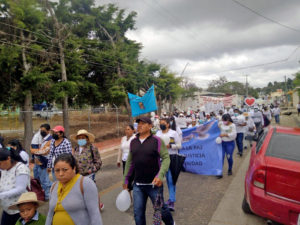
Pilgrimage for Peace, for Life, against Violence and Discrimination, Las Margaritas, February 2022 © SIPAZ
In February, around two thousand indigenous people from Believing People made a pilgrimage in the municipality of Benemerito de las Americas to demand the suspension of two palm oil processors, due to the contamination they generate in their territory. They explained that they have filed complaints with various government agencies but have received no response. They also questioned labor exploitation in these companies. They raised other requests “such as health, provision of medicines, construction of hospitals, more doctors. In terms of violence, the localities suffer from organized crime, kidnappings, robberies of properties and murders”.
Likewise, in February a confrontation took place in Las Margaritas that ended with two people dead and several injured. This, residents of this municipality say, was just one more example of the violence that has co-opted the state and that is spreading more and more visibly throughout the territory. In this context, churches of different religious denominations convened the “Pilgrimage for Peace, for Life, against Violence and Discrimination” that took place in March. They announced the creation of the “Alliance of Churches for Peace” that will seek to work together for the common good “in the midst of the serious deterioration that our entire state of Chiapas is now experiencing.”
In April, the Second Zoque Congress was held to “build collective solutions to (…) the imposition of extractive projects, forced displacement of families, exacerbation of national and international migration, as well as interest in privatizing water, lands and the Chichonal volcano.” The participants also denounced the violence caused by armed groups, as well as the division and co-optating by assistance programs. They also expressed their concern about the “reactivation of energy projects that seek the construction of new hydroelectric dams in the municipalities of Chicoasen, Copainala and Francisco Leon.” They recalled that in 2016 they managed to mobilize to avoid the concession of land for the exploitation of twelve oil wells. They expressed that “today, as before, we have decided not to sell out, not betray ourselves and not give up.”
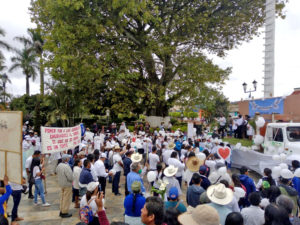
Pilgrimage for Peace, for Life, against Violence and Discrimination, Las Margaritas, February 2022 © SIPAZ
Similarly, in April, around 400 residents of different communities in the municipality of Chilon gathered in the community of Pamal-Navil to make a pilgrimage for life, justice, unity and dignity for Mother Earth and the peoples. The demands of the Tseltal people were made known: respect for Mother Earth, the defense of their territory and absolute freedom for community defenders Cesar Hernandez and Jose Luis Gutierrez prosecuted for the crime of mutiny since 2020 after demonstrating against the construction of a National Guard barracks in their territory.
Highlighting other types of concerns, in March thousands of Zapatistas filled the streets of San Cristobal de Las Casas, Ocosingo, Palenque, Las Margaritas, Altamirano and Yajalon to protest against the capitalist wars that “oppress the peoples and destroy mother earth in all geographies. They showed their solidarity not only with “the resistance of Ukraine and Russia” but also “with all the peoples where war conflicts prevail such as Palestine, Kurdistan, Syria, the Mapuche people, the original peoples throughout the planet and so many libertarian processes that are attacked, persecuted, murdered, silenced” (see article).
OAXACA: Worsening of the situation of free expression and the defense of human rights in the state
In the last nine years, 11 journalists have been murdered in Oaxaca. Another alarming number is that of the investigation files for human rights violations of journalists and communicators in the state: the Ombudsman for the Human Rights of the People of Oaxaca (DDHPO) registers 288.
In April, journalists protested to demand justice for the murders of journalists Heber Lopez (February 2022) and Gustavo Sanchez (June 2021), during the dialogue held by the Mechanism for the Protection of Human Rights Defenders and Journalists in Juchitan. They spoke with banners bearing the slogan #PeriodismoEnRiesgo (#JournalismAtRisk), in solidarity with journalists attacked in the region and demanding justice for those murdered communicators, as well as their families. At this same event, social organizations from the region also demonstrated, exposing the human rights violations of activists in the face of the dispossession of their lands for the development of wind projects and the Tehuantepec Isthmus Interoceanic Corridor.
In May, within the framework of another round table organized by the Mechanism in Tlaxiaco, displaced residents of Guerrero Grande demanded the appearance alive of defender Irma Galindo Barrios, who disappeared in October 2021. This environmentalist defender of forests in the Mixteca disappeared in Mexico City while she was collecting supplies for communities in the municipality of San Esteban Atatlahuca that were attacked at the end of October after denouncing the depredation of their natural resources. “No one should disappear for defending nature”, claimed the protesters who since October 2021 have not been able to return to their homes that were burned by people supposedly related to local authorities.
It should be noted that Oaxaca is the second entity with the most beneficiaries of the federal Protection Mechanism, with a total of 153 people.
GUERRERO: Mexican Army involved in the Ayotzinapa case
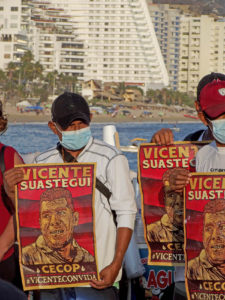
Demonstration to demand the presentation alive of the defender of territory, Vicente Suastegui Muñoz, Acapulco, March 2022 © SIPAZ
In March, the Interdisciplinary Group of Independent Experts (IGIE) of the Inter-American Commission on Human Rights (IACHR) presented its Third Report with the findings of the investigations they have carried out into the disappearance of the 43 student teachers from Ayotzinapa in September 2014. The evidence collected reveals that both the Army and the Navy were involved in the disappearance and in the manipulation of information for seven years. They indicate that the Ayotzinapa students had been under investigation for years; that there were soldiers infiltrated inside the school; that four days before the disappearance, the Command of the 35th military zone ordered all the Guerrero battalions to follow the students; that on the day of the disappearance, both the police and the military maintained detailed monitoring of the students, including the interception of communications in real time; that said information was not shared with the authorities in charge of the investigation; among others. They presented an unpublished video recorded by a drone from the Secretary of the Navy, in which elements of said institution are seen entering the Cocula dump (key place of the investigation in 2014) and manipulating the scene.
In May, relatives of the 43 affirmed that “the authorities in charge of investigating have been able to do little to force the Mexican Army to provide the related information, on the contrary, the agreements of the federal executive with this institution allow us to conclude that the government is not willing to strain relations, much less allow them to be prosecuted, despite the fact that the president has publicly reaffirmed his commitment to clarify the facts and punish the guilty.”
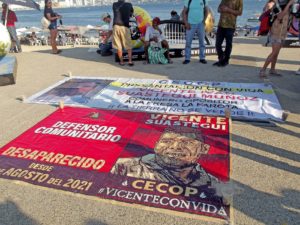
Demonstration to demand the presentation alive of the defender of territory, Vicente Suastegui Muñoz, Acapulco, March 2022 © SIPAZ
Given the resistance to resolve a case as emblematic as that of Ayotzinapa, there is little hope for more recent cases. In May, a political act was held in Acapulco to demand the presentation alive of the defender of the territory, Vicente Suastegui Muñoz, who has been missing since August 2021. He is a member of the Council of Ejidos and Communities Opposed to La Parota Dam (CECOP ) therefore, “…we maintain that Vicente’s disappearance is for political reasons, for his participation in defense of the land. The CECOP is a movement that has been repressed, several have fallen, they have been deprived of their liberty and have had to live with anxiety”, stated La Montaña Tlachinollan Human Rights Center.
Likewise, in May, the Regional Coordinator of Community Authorities-Community Police (CRAC-PC) requested “a prompt, exhaustive and impartial investigation into the murder of the defender of the rights of the Afro-Mexican people, Luis Ortiz Donato, which occurred last Thursday, April 28th“ in the municipality of Marquelia. Likewise, they emphasized that “his murder is a deadly message from powerful groups and organized crime, who feel protected by a state justice system that does not investigate crimes against defenders.”

